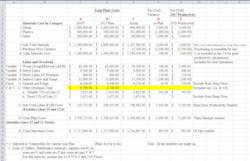Ask the Expert: Lean Leadership -- The Productivity Equations
Editor's Note: In this Ask the Expert article, Larry Fast addresses two questions prompted by his January column: Performance Metrics that Matter: Effective Productivity Measures.
Question: When you say "OEE results dollarized," what exactly do you mean? Is it possible to give an example for each of the KPIs (discussed in this article)?
Answer: The first important step to "dollarize OEE" is to have a Chart-of-Accounts (COA) that allows you to collect and analyze the data you need to be actionable. You may find the COA in your company to be pretty vanilla based on the accounting department's needs to collect and report financial information. How this is done may or may not be of much use to you in the factories.
The COA isn't just an accounting exercise. If affects every part of the business. To set up a COA that varies from the purchased "canned system" sometimes requires modifications to assist in the collection and reporting of data that leaders at all levels can use in a practical way. Modifications are typically frowned upon by the system provider and the local IT department. The key point here is that accounting has two compelling customers, one external and one internal.
My experience is that the financial reporting piece trumps other internal needs. The CEO and CFO are accountable and extremely sensitive to the need for accurate reporting of the numbers, as they must be. There are numerous government entities with regulations, reporting requirements and controls that cannot be breached; as well as shareholders to satisfy--many of whom are in the field of finance. I get it. No wiggle room here.
What I don't get is why it isn't as important to provide the kind of accounting infrastructure for the largest users of the systems, i.e. operations, as well as the other functions of the business, to make it much easier to report and collect the data necessary to drive improvements.
The place to start is to sit down with your accounting experts and find out what already exists that can be helpful by simply writing a report generator that puts the information into a format that is actionable. (Be sure your hands are clean in terms of accurate reporting of the correct data. If they aren't, initiate corrective action immediately. There's nothing more frustrating for accounting and systems people than to be blamed for numbers coming out on reports that aren't believable. Sometimes it's their problem, but my experience is that it's often the users' problem by not supplying accurate and timely inputs needed for a credible report. No "garbage in/garbage out" allowed!)
Secondly, your accounting folks may be naive about what you need since inter-functional engagement and collaboration often are rare. So think hard about what you need, and why, and to understand the source of the information. This work is a longer term solution, but you need to get into the schedule with the necessary actions prioritized to your needs.
To Answer Your Questions...
Now I'll get to the question raised by readers. My response will be based on a skeleton COA I've put together as a simple example that I hope you'll find helpful. With accounting department help you can, and likely should, have a much more extensive COA than the elementary one I've used to go through the formulas for productivity.
All the numbers on the worksheet are made up and serve only to assist your understanding of the thinking required and the mechanics necessary to collect and report productivity information. I should also point out I am not a cost accountant nor am I a whiz at doing Excel spreadsheets, so be kind.
I am just a leader who many years ago sat with plant accounting experts and my plant manager mentor and learned how the cost system was structured; how to read and understand the numbers and their effect on manufacturing; and how it would influence my performance in the shop. I thought that was really important since the contents of the chart of accounts are a critical part of measuring performance to objectives and for seizing opportunities to get better.
Here's the simplified COA for your review before I continue.
CHART OF ACCOUNT: Columns Key
- A. Run the 2017 Production Plan using the 2016 Actual Costs adjusted for 2017 Volume and Mix. This is your baseline for calculating Year-Over-Year (YOY) Productivity.
- B. The 2017 Plan is the budget as rolled up to Corporate.
- C. Actual numbers reported for the time period. (The spread sheet is for 1 month. When you make your COA reports, be sure you also have an updated YTD summary for the year.)
- D. This is the Variance plus or minus to the 2017 Plan/Budget.
- E. This is the Actual Cost Change, adjusted for Volume and Mix, YOY. THIS is your Productivity number for the Shop Floor-line 13, the Plant Manager-line 14 and the VP Operations-line 15.
Also note: The "Plan number" (Budget) is what the plant has committed to in the Corporate financials. As you can see, there is a good amount of "headroom" above and beyond the plan. If all the stars line up on your projects and performance soars, you can reforecast a better outcome for upcoming quarters, and the corporation can communicate the higher performance to Wall Street and Shareholders. The degree of "headroom" is one of the negotiables during budget planning to be sure there's not too much "sand bagging." Now onward to the three productivity metrics details.
Shop Floor Productivity (Supervisors/Value Stream Managers/Production Managers)
Option # 1 OEE: Original Equipment Effectivity = Utilization x FPY x Efficiency
Remember that OEE numbers are geared to help shop-floor supervisors track their performance hour by hour, 24/7. That's how the OEE numbers must be made, one hour at a time. And that's the supervisors' and operators' jobs and the indirect folks who support them.
Utilization: The hours the equipment is actually running vs. scheduled capacity, i.e. from first good part to last good part prior to changeover. Focus is on the constraint of the value stream or department and keeping that equipment running through shift changes and as close to continuous as you can engineer. This result feeds into Option #2 below in the form of Direct Labor costs plus Direct Labor on Indirect Labor duties such as changeovers, maintenance downtime and the like. Any time the capacity-constrained machine is not being utilized at the Plan rate is a negative to performance.
First Pass Yield: If your FPY is 90%, the remaining 10% is accounted for by the amount of wasted Material, Labor and Overhead due to scrap plus rework Labor and Overhead, if any. This calculation feeds into Option #2 below to dollarize the 10% loss.
Efficiency: The percentage of time the equipment is running at rated speed. (Note: Some companies also track material usage variances. Depending on your process and the percentage of your costs for materials, and depending on the accuracy of your BOMs and Routers, material usage variances can be significant.)
Option # 2, Dollarize OEE: This is a necessary calculation for all three levels of productivity reporting. The "dollarization of OEE" expresses the outcome in dollars so the financial impact is known by machine, shift, by value stream or department. The total of all value streams or departments is the total shop-floor number. We're looking to identify all actual variable and fixed factory costs spent in the shop for a specific timeframe. The ideal situation for enhanced management control is to have both of these robust OEE measures with Option # 1 for hour-to-hour execution and control by supervision and the #2 Option geared more for the manager level.
Referring to the Chart of Accounts, use line 4, which is the cost of Direct Materials excluding any variance due to changes +/- in the purchase price of all raw materials, Line 5. [Your sourcing/purchasing group is accountable for Purchase Price Variance (PPV).]
For the Shop Floor metric, calculate the relevant Labor and Overhead, i.e. line 7 + line 8 + line 9 + line 10 + the variable part of line 12, i.e. 12a. In the case of Line 4, the relevant shop floor number is the variance to Plan and Productivity, Columns D and E. These reflect shop-floor performance on materials. For Overhead, the 75% Variable recognizes the link between actual costs and the volume in the shop. The 25% Fixed expense means those expenses don't fluctuate due to plant volumes. (e.g., a high percentage of utilities cost varies directly with production levels, whereas things like travel expense and office supplies don't. You need one cost accountant whether the plant is running wide open or at 70 % of capacity.)
In summary, add lines 7, 8, 9, 10 and 12a., plus or minus material cost Variances, line 4. This results in actual shop floor costs compared to Plan (Column D), and to the prior year adjusted numbers (Column E) for the resulting productivity on the shop floor.
NOTE: To simplify the examples, I have assumed very modest changes in volume and mix year-over-year. When you commit to this set of metrics, pull in your Plant Controller/Accountant right away. Using the 2016 costs, adjusted for the Planned 2017 Volume and Mix, you'll have the basis of capturing the total difference in total spending year-over-year to the Plan (Column D). Now you have an apples to apples comparison because you have normalized Volume and Mix. Then compare the Actual Total Plant Costs to Column E. The result is Productivity which can be traced directly to the income statement.
Plant Productivity (Plant Manager and Staff)
Now that you have the dollarized OEE shop floor metric, take that result and add to it Total Materials Cost and Actual Period/Fixed Costs in the plant. In other words:
Add lines 4,7,8,9,10 plus all of lines 11 and 12. This also includes the total spend for materials excluding PPV. This sum equals your Total Plant Costs (Column C). Compare that total to the budget (Column D) and the adjusted prior year (Column E). Materials costs are relevant at the plant manager level because of the need for staff managers to keep accurate inventory records, do timely reorders of materials, and provide warehouse and trailer security and the like for plants that still manage materials conventionally. (For plants that have more advanced processes, such as just-in-time supplier relationships, use of visual management/kanbans on the floor, etc., you should take this into consideration for this metric.)
Typically the above calculation is the Productivity number that the plant manager and staff would be accountable for.
Total Operations Productivity (VP and Staff)
As I looked back over my formula from the original article, it's a bit confusing, so let me try again here.
Take Actual Total Plant Costs number-line 14, Column C, + Total Raw Materials Cost Variance-line 5, and compare that total to Column D to report Variance to Plan. Compare the same totals of lines 14 and 5 to Column E for Total Operations Productivity.*
*(The SVP/VP of operations often has purchasing under operations. If this isn't the case, the senior operations leader should be interacting directly with the appropriate counterpart to properly record and be accountable for this part of the total production costs.)
Finally, as you work through the numbers in your own operations, remember the purpose of these metrics: To tell the truth and have traceability from operations' performance to the income statement of the business. In other words, REAL productivity!
"Don't lower your expectations to meet your performance. Raise your level of performance to meet your expectations. Expect the best of yourself, and then do what is necessary to make it a reality." Ralph Marston
"Make the numbers." Stephen Rabinowitz, Former CEO, General Cable Corp.





